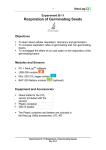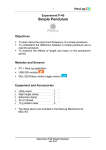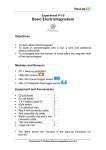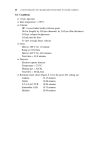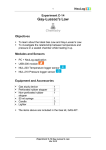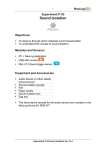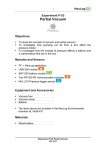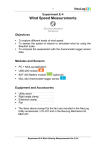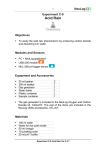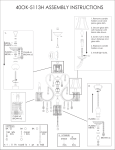Download Experiment C-5, Combustion
Transcript
1 Experiment C-5 Combustion Objectives To study the chemical process of combustion. To measure the oxygen levels during the combustion of a candle. Modules and Sensors PC + NeuLog application USB-200 module NUL-205 Oxygen logger sensor Equipment and Accessories Cover Candle base Candle The items above are included in the NeuLog Oxygen and Carbon Dioxide kit, CGG-KIT. Materials Lighter DO filling solution (included with the oxygen sensor) Experiment C-5 Combustion Ver 3.3.6 2 Introduction Combustion is an exothermic reaction between a fuel and an oxidizing agent, usually accompanied by the production of heat and light in the form of flames. Many organic compounds burn in the presence of oxygen (air contains approximately 21% oxygen) to produce water and carbon dioxide. For example: methane (a natural gas), which burns in the air to produce water, carbon dioxide and maybe the most important additional product, heat. This energy in the form of heat is used to warm houses: CH4 + 2O2 CO2 + 2H2O + energy (heat) A similar reaction to combustion of organic compounds is cellular respiration. C6H12O6 + 6O2 6CO2 + 6H2O + energy (ATPs, heat) In this reaction, like in the combustion reaction, an organic compound reacts with oxygen to produce water, carbon dioxide and energy. It is common to think that combustion ends when all the oxygen is consumed. In this experiment, we will investigate it by burning a candle in a closed container while monitoring the oxygen content. Experiment C-5 Combustion Ver 3.3.6 3 Procedure Experiment setup Caution: You will be working with an open flame. Make sure not to have any flammable material in the proximity of the experiment. Be careful when working with high temperatures. It is recommended to wear personal protective equipment. 1. Set up the experiment as shown in the picture below. 2. Remove the rubber protection from the oxygen sensor's probe cap. Unscrew the cap, fill half of it with the included liquid and screw it back. 3. Place the probe in the side hole of the candle base. 4. Place the candle in the candle base. Experiment C-5 Combustion Ver 3.3.6 4 Sensor setup 5. Connect the USB-200 module 6. Check that the oxygen sensor USB-200 module. to the PC. is connected to the Important: You must wait about 5 minutes after connecting the sensor to the USB-200 module before beginning calibration and measurements. For a more accurate measurement you can look at the module window and wait for the reading to stabilize (it could take longer than 5 minutes). Note: The following application functions are explained in short. It is recommended to practice the NeuLog application functions (as described in the user manual) beforehand. 7. Run the NeuLog application and check that the oxygen sensor is identified. Experiment C-5 Combustion Ver 3.3.6 5 Settings 8. Click on the On-line Experiment icon main icon bar. in the NeuLog 9. Click on the Sensor's Module box. 10. Click on the Range button. 11. Select the "% in air" button to change the sensor's mode to oxygen percentage in air. 12. Click on the Experiment Setup icon and set the: Experiment duration to 2 minutes Sampling rate to 60 per minute Experiment C-5 Combustion Ver 3.3.6 6 Testing and measurements 13. Press on the sensor’s offset button continuously (3 seconds), or click on the calibrate button in the Module setup dialogue box. This will offset the sensor to a value of 20.9%. 14. Light the candle and check that the oxygen levels are stable in the module window. 15. Click on the Run Experiment icon measurement. 16. Wait about 10 seconds and cover the candle with the glass cover. 17. Note how long it took for the candle to get extinguished. 18. Observe the changes in the oxygen percentage (stop the measurement if the value has stabilized). 19. Click on the Zoom fit icon 20. Your graph should be similar to the following: Cover was placed . Candle extinguished Experiment C-5 Combustion Ver 3.3.6 to start the 7 21. Save your graph. 22. After placing the cover, oxygen molecules cannot get in the container and the oxygen level decreases as the candle is burning. We can see in the previous graph that a few seconds after the candle was extinguished, the measured oxygen levels were minimal (diffusion rates of oxygen in the container might cause this small delay). 23. Click on the Select Zone icon and select the part between the beginning and ending of the measurement. 24. Look at the data at the bottom of the graph, we can see that the oxygen level had changed in our example from 20.9% to 15.4%. The measured minimum oxygen level matches the measured value in caves with low concentrations of oxygen. The study showed that bellow 15% oxygen, candles extinguish. Experiment C-5 Combustion Ver 3.3.6 8 Usually the oxygen concentration measured is the Minimum Oxygen Concentration (MOC) required for combustion. This value is different between fuels and depends on the stoichiometric relations (quantitative relations) between the oxygen and fuel. Summary questions 1. What was the minimum oxygen percentage in your measurement? Does this value match the documented data from caves? 2. What was the fuel in the experiment? Was it solid, liquid or gas? 3. If we would have used a larger container, how do you think this would affect the results? 4. Which chemical product that was not mentioned could also be a result of combustion? What is the effect of this product on our health? Experiment C-5 Combustion Ver 3.3.6









